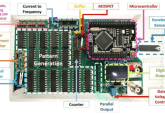Miniature biopsy-implantable biochemical sensor could assist clinicians against cancer
Researchers from MIT’s Koch Institute for Integrative Cancer Research (MA, USA) have developed a biopsy-implantable biochemical sensor that can be implanted in cancerous tissue during initial biopsy. The team described the sensor in a recent issue of Lab Chip.
The sensor can wirelessly send data regarding biomarkers to an external device reader, which will allow clinicians to monitor patient progress and adjust dosages or switch therapies accordingly.
Utilizing this data may allow targeted cancer treatments boosting efficacy while reducing patient exposure to side effects.
Currently, clinicians lack a reliable method of obtaining real-time data for cancer progression, relying on imaging and scanning technologies for indicating the size of tumors and invasive biopsies for further information. However the nature of these methods only allow for a snapshot of tumor response.
“We wanted to make a device that would give us a chemical signal about what’s happening in the tumor,” commented Michael Cima, a Koch Institute investigator who oversaw the sensor’s development.
“Rather than waiting months to see if the tumor is shrinking, you could get an early read to see if you’re moving in the right direction.”
The sensors provide data concerning two biomarkers linked to the tumor’s response to treatment: pH and dissolved oxygen. Measuring the cancerous tissue for these biomarkers presents clinicians the ability to monitor patients and therapies in real-time.
The sensor is assembled from biocompatible plastic, similar to those utilized in other implantable electronics such as pacemakers and defibrillators.
The device is small enough to fit in the tip of a biopsy needle and contains 10 microliters of chemical contrast agents typically used in MRI as well as a circuit deployed to communicate with the external reader device.
The sensor itself is powered by the principle of mutual inductance – utilizing metal coils in the senor and the reader.
The team successfully tested the sensors using rodent models; however they were only trialed for a few weeks. The initial experiments demonstrated that the sensors could rapidly, accurately and reliably detect pH and oxygen concentration in cancerous tissue.
Further research will be conducted to measure the sensor’s ability to measure these changes over an extended period of time.
“I want to push these probes so we can use them to monitor tumor response,” Cima stated. “We did a little bit of that in these experiments, but we need to make that really robust.”
While the primary application of these sensors would be within cancer treatment, they may have applications within other fields such as environmental science as Cima explains: “you could use these to measure dissolved oxygen or pH from a lot of different sites all over a pond or a lake. I’m excited about using these sensors to bring big data to environmental monitoring.”
Sources: Vassiliou CC, Liu VH, Cima MJ. Miniaturized, biopsy-implantable chemical sensor with wireless, magnetic resonance readout.” Lab Chip doi: 10.1039/C5LC00546A (2015); http://news.mit.edu/2015/real-time-data-for-cancer-therapy-0804






